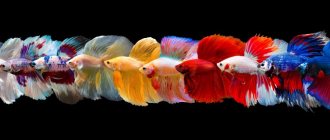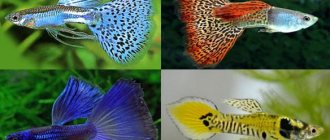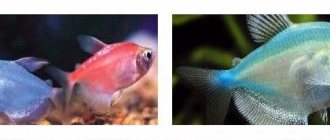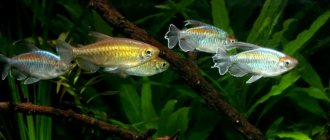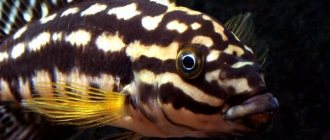5
(2)
Persistent, easy-going and tireless Limia, unfortunately, is not very popular in aquarium stores, but in vain. For a beginner, she is an excellent candidate who will forgive him many mistakes in keeping and will delight him with the appearance of the fry. For an experienced lover of the underwater world, it will bring variety and novelty after keeping guppies and swordtails.
Habitat
There are other names for limia: humpbacked, speckled, Cuban. They are determined by appearance and habitat. The fish's homeland is considered to be the Caribbean off the coast of Haiti. However, individuals can be found in Latin America, Cuba, and Jamaica. Under natural conditions, representatives of the species prefer to stand in shallow bodies of water near dense thickets. The fish is found in small rivers and oxbow lakes. Does well in fresh and brackish water. Individuals do not live alone; in natural conditions they live in packs and families. Limia does not eat plants, preferring duckweed for food. Gets along well with other fish species. Thanks to these characteristics, the fish has become an inhabitant of home aquariums.
Description
The size of the fish is small, the mouth is upper (the lower jaw is larger than the upper, the mouth opening is directed upward). Large black eyes have a small edge. Males are smaller, distinguished by a narrow keel and tall body. They reach a length of 5 cm. Females can grow up to 7 cm. The fish have a high humpbacked back, which abruptly turns to the head. Individuals are distinguished by a wide caudal peduncle. The body is characterized by a greenish-olive color with a silvery tint; there are from 7 to 12 dark transverse stripes on the sides. The area around the head and abdomen has a distinct golden hue. The yellow dorsal fin is shaped like a fan (in females it is small and transparent). The presence of dots or black stripes on the rays is characteristic; the caudal fin may have spots. The male Limia has a brighter and more contrasting color. When lit from the side, there is a beautiful emerald reflection on the sides.
Reproduction
Black-striped limias are viviparous representatives that do not lay eggs, but immediately release full-fledged fry. They incubate in the female's body. Under comfortable living conditions, the female is able to reproduce every 7-8 weeks. Each brood contains up to 60 fish.
With the onset of the mating season, breeding males become more active and begin to chase their favorite partners. To avoid confusion, it is advisable to have one male per female. The fertilized individual is placed in a separate container and returned to the general aquarium after spawning. This is due to the predilection of fish to eat their brood.
More vegetation is placed in the spawning tank and bright lighting is created. The temperature is maintained at no lower than 28 C. The expectant mother is fed plant foods so that she gives birth faster. Pregnancy lasts about 40 days.
The fry are fed almost from the first days of birth. To do this, use live dust, brine shrimp, and crushed egg yolk. As soon as the juveniles are fully formed and strong, they are placed in the general population.
Sex differences
It is easy to distinguish males from females by size and color. Males are more graceful and compact, with an olive back and yellowish-green sides, shimmering with mother-of-pearl. Another characteristic feature is a highly elevated spinal ridge.
Black-striped limias are attractive and playful fish, constantly scurrying in schools in the water layers. They are interesting to watch. In addition, they bring benefits - they clean the environment from duckweed, which often appears in aquariums.
Nutrition
These aqua fish are constantly in search of food, examining the soil and plants. They love to eat algae growths on the decorations of the aquarium, effectively cleaning it. A balanced, comprehensive diet is a necessary condition in caring for your pet. The fish is unpretentious in food, but it is necessary to include animal food in the diet, supplementing it with plant foods. All types of food are suitable for feeding Limia:
- alive;
- frozen;
- dry.
Bloodworms, coretra, frozen cyclops, daphnia, and tubifex are often used. You can give white bread, cottage cheese, flakes with spirulina and other types of food.
What to feed Endler's guppies?
Endler's guppies are practically omnivores, they happily eat small live food: brine shrimp, daphnia, cyclops, but it is better to refuse bloodworms, since Endler's guppies have a very small mouth, they can simply choke on thick bloodworms.
The fish also eat dry food with great pleasure; it is also advisable to grind it by rubbing it with your fingers.
Do not forget that the main diet of Endler guppies is plant foods, so they need to eat food with a high content of spirulina, otherwise the fish may develop problems associated with the digestive system.
Never overfeed Endler's guppies, they are prone to obesity, and this fact does not have the best effect on reproductive ability.
Adults can be fed once or twice a day; once a week, be sure to arrange a fasting day for the fish. Daily fasting will benefit your Endler guppies.
Fry should be fed 3 to 5 times a day in small portions.
If you are leaving somewhere for a long time, then do not feed your fish. Under natural conditions, Endler's guppies are able to withstand a month-long hunger strike, so there is no need to worry about the fish dying from starvation.
Feeding aquarium fish should be correct: balanced, varied. This fundamental rule is the key to the successful keeping of any fish, be it guppies or astronotuses. The article “How and how much to feed aquarium fish” talks about this in detail; it outlines the basic principles of the diet and feeding regime of the fish.
In this article, we note the most important thing - feeding fish should not be monotonous; the diet should include both dry food and live food. In addition, you need to take into account the gastronomic preferences of a particular fish and, depending on this, include in its diet food either with the highest protein content or, conversely, with plant ingredients.
It should be noted that when purchasing any dry food, you should pay attention to the date of its manufacture and shelf life, try not to buy food in bulk, and also store food in a closed state - this will help avoid the development of pathogenic flora in it
Maintenance and care
Limia is a schooling, territorial fish. Individuals are kept in groups. It is possible to place it together with other species of fish or separately in a species aquarium. Basic recommendations:
- For the good health of the fish, the optimal number of individuals is from 6 to 8.
- It is necessary to take care of the proximity to peaceful species of small fish.
- When choosing an aquarium, the required swimming space is taken into account. There should be 7-10 liters per individual. The recommended length of the aquarium is from 60 cm.
- Ensure there is dense vegetation and floating plants. It is recommended to arrange thickets around the perimeter of the aquarium, leaving the front wall empty. There should be enough space in the center for free movement.
- Limia loves shelters that need to be arranged. This moment is especially important for females and juveniles.
Limia needs natural light. During the day, the aquarium should be exposed to natural sunlight for at least 2 hours. It is necessary to equip artificial lighting with lamps (fluorescent or incandescent). They must contain an enhanced red spectrum of radiation. This technique increases the activity of the fish and affects the brightness of their color. However, the radiation should not be too bright. Permissible lighting intensity is within 0.5-0.7 W/l. Limia has a hard time with changing water due to sensitivity to sudden fluctuations in the composition and properties of the environment. It is not recommended to change the entire volume of liquid in the aquarium at once. Frequent changes should be made in small portions. It is recommended to change 10% of the total volume in 2 days. It is important for fish to comply with water requirements:
- The environment must be neutral. The optimal pH level is 7 or 8. Limia feels comfortable in hard water at a dH of 12-25°.
- It is necessary to maintain the temperature in the range of +24…+28°C.
- Water can be added with salt, but the content of the element should not exceed 5%.
- Installation of a reinforced filtration and aeration system is required. Among the accessories presented in stores, it is preferable to choose a biological filter due to the sensitivity of lymphoma to nitrates.
Small and medium pebbles are suitable as soil.
Feeding the Blue Dreamy shrimp
Blue dream shrimp photo
Feeding blue dream shrimp is very easy, as they are omnivores and will accept virtually any type of food made for shrimp or fish: blanched spinach, zucchini, seaweed, shrimp pellets, fish flakes, bloodworms and much more.
It is worth paying attention to the feeding time interval, which is a good indicator of health
It is better to feed once a day. The amount of food required for shrimp should be consumed within a maximum of 2-3 hours. Excess feed is bad for shrimp. Overfeeding can lead to their death and also affect the quality of water in the aquarium. Remember that shrimp are waste collectors. They eat whatever they find 24 hours a day, 7 days a week.
Blue dream shrimp photo
Feeding any aquarium fish and shrimp must be correct: balanced, varied. This fundamental rule is the key to successful content. The article “How and how much to feed aquarium fish” talks about this in detail; it outlines the basic principles of the diet and feeding regime of the fish.
Remember that feeding fish and shrimp should not be monotonous; the diet should include both dry food and live food: protein and vegetable.
Popular and popular food for fish, shrimp and crustaceans, of course, are dry food. For example, you can constantly and everywhere find food from Tetra, the leader of the Russian market, on aquarium shelves. In fact, the range of food from this Tetra is included as individual food for a specific type of fish: for small ornamental fish (Tetra Micro Food), for goldfish, for cichlids , for loricariids, guppies, labyrinths, arawans, discus, etc. Tetra has also developed specialized foods, for example, to enhance color, fortified, or for feeding fry. For shrimp and crustaceans, the Tetra line includes the complete food Tetra Crusta. You can find out detailed information about all Tetra feeds on the company's official website - here.
It should be noted that when purchasing any dry food, you should pay attention to the date of its manufacture and shelf life, try not to buy food in bulk, and also store food in a closed state - this will help avoid the development of pathogenic flora in it
Diseases
Lymia rarely gets sick. Health problems in fish occur more often under inappropriate conditions:
- the water is not renewed, becomes cloudy, and becomes polluted with waste;
- an inappropriate level of acidity or hardness is maintained;
- the aquarium was equipped incorrectly (too bright lighting, lack of shelters, insufficient space, incorrect temperature conditions);
- incorrect choice of neighboring fish species;
- feeding spoiled food, lack of herbal supplements in the diet.
Lymia can develop after an injury. Any of these factors can provoke a decrease in immunity in fish. This affects the well-being of the individual and increases the likelihood of infection by pathogenic microorganisms. There are dozens of diseases of aquarium fish, characterized by a different set of symptoms:
- constant presence at the surface of the water or at the bottom, in places of shelter;
- loss of appetite;
- difficulty swimming, including upside down;
- friction against objects in the aquarium;
- severe weight loss;
- swollen abdomen;
- bristling of scales;
- fading of color, appearance of spots on the body;
- pressed state of the fins;
- 1 or 2 eyes are bulging or changed shape;
- change in color of excrement;
- the appearance of microorganisms, rash.
If changes in the behavior of the fish are detected, the water should be checked for compliance with the necessary parameters and the content of toxic substances. If, after normalizing environmental indicators, the condition of lymia does not improve, treatment is carried out. First, it is recommended to show the fish to a specialist for diagnosis in order to correctly identify the disease.
Limia breeding
The average lifespan of fish in an aquarium is 3 years. Individuals reach sexual maturity at the age of 4 months. A female ready to spawn can be identified by her rounded abdomen and darkened area of the anus. It should be placed in another aquarium. In the spawning tank, it is necessary to ensure the presence of dense plants planted in the main aquarium. The water is slightly salted. The temperature in the depositor should be maintained at 28°C. After spawning, the female is removed so that she does not eat the offspring. Limia is a viviparous fish species. Pregnancy lasts from 28 to 40 days. During 1 spawning, up to 50-60 fry appear, the length of which ranges from 8 to 12 mm. When bearing offspring, it is necessary to monitor the appearance of the female’s abdomen. If it is overcrowded, experienced aquarists will add a male. He makes attempts to mate and hits the female's sides with his head. This helps prevent the embryos from growing too much. The measure is necessary so that, with large embryos, the female does not die during childbirth or due to a breakthrough in the abdomen during gestation. From the first days of life, the fry immediately begin to swim and feed on their own. With a good diet, they develop and grow quickly. For starter food after spawning, “live dust” is used. This concept means the smallest living food that does not spoil the water: ciliates, rotifers, newly born cyclops and daphnia. Over the course of 2 weeks, the juveniles are gradually transferred to dry and live food for adults. Breeding Limia seems simple at first glance. However, the fry are sensitive to changes in water properties, maintenance regime, and are susceptible to skin parasites. This becomes the reason that breeding does not always go smoothly.
Endler's guppy compatibility
If you do not know what compatibility is and why it is necessary, then we recommend that you familiarize yourself with this material.
Endler's guppies can coexist in an aquarium with small fish, for example: neons, zebrafish, various types of rasboras, corydoras, acanthophthalmus, small species of iris (Iriaterina Werner), cardinals. However, Endler's guppies are conditionally compatible with all of the above, since they require different water parameters. Cohabitation with platies, mollies, and swordtails is possible. The latter can greatly pester Endler's guppies, so it is better to abandon swordtails. Ordinary guppies are also not suitable as neighbors due to free crossing between species.
Endler's guppies are not compatible with any large or aggressive fish.
Still, the ideal solution would be a species aquarium in which Enler’s guppies will live and breed peacefully. Such an aquarium will not seem boring due to the wide variety of colors.
